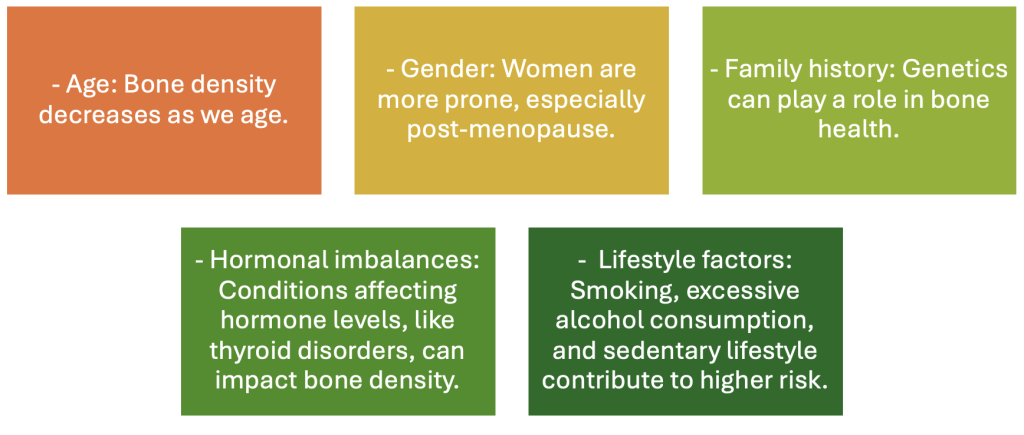Osteoporosis, often called the “silent disease,” weakens bones, making them brittle and more susceptible to fractures.
This guide provides practical tips for preventing and managing osteoporosis, covering dietary recommendations, exercise routines, and medical treatments.
Osteoporosis is a condition characterised by decreased bone density and quality, leading to fragile bones that can break easily. The disease progresses silently, often without symptoms until a fracture occurs.
Bone density naturally decreases with age, but osteoporosis accelerates this process, especially in postmenopausal women and older adults.
Risk factors:

Dietary Tips for Stronger Bones
Calcium is crucial for bone health. Aim for:
- Dairy Products: Milk, cheese, and yoghurt.
- Leafy greens: Kale, broccoli, and spinach.
- Fortified foods: Some cereals and plant-based milks are fortified with calcium.
- Calcium supplements: Consider supplements if dietary intake is insufficient, but consult with a healthcare provider for proper dosage.
Vitamin D helps the body absorb calcium. Sources include:
- Sunlight: Spend time outdoors to stimulate natural vitamin D production.
- Dietary Sources: Fatty fish (like salmon and mackerel), fortified foods, and egg yolks.
- Supplements: Vitamin D supplements may be necessary, especially in areas with limited sunlight or for individuals with low blood levels.
A diet rich in fruits, vegetables, and lean proteins supports overall health and bone strength. Foods high in vitamin K (such as green leafy vegetables) and magnesium (such as nuts and whole grains) also benefit bone health.
Excessive caffeine and alcohol can interfere with calcium absorption and contribute to bone loss. Limit coffee consumption to 2-3 cups per day and moderate alcohol intake.
Exercise Routines for Bone Health
1. Weight-bearing exercises
These exercises force you to work against gravity, promoting bone formation. Examples include: walking, jogging, dancing.
2. Strength training
Building muscle mass supports bone health and helps prevent falls. Consider:
- Resistance bands: Affordable and versatile for strength training.
- Free weights: Incorporate exercises like squats, lunges, and shoulder presses.
- Weight machines: Useful for controlled strength training.
3. Balance and flexibility exercises
Improving balance reduces the risk of falls, which can lead to fractures:
- Tai Chi: Promotes balance, coordination, and flexibility.
- Yoga: Enhances flexibility and core strength while improving posture.
- If you have osteoporosis, avoid activities that put excessive stress on your bones, such as heavy weightlifting or high-impact sports.
Medical Treatments and Preventive Measures
1. Medications
For individuals diagnosed with osteoporosis, several medications can help:
- Bisphosphonates: Reduce bone loss and increase bone density.
- Hormone Replacement Therapy (HRT): Useful for postmenopausal women, but discuss with a healthcare provider.
2. Bone Density Testing
Regular bone density tests, such as a Dual-Energy X-ray Absorptiometry (DEXA) scan, help monitor bone health and guide treatment decisions.
3. Fall Prevention
To reduce the risk of fractures:
- Remove tripping hazards, install grab bars, and use non-slip mats.
- Regular eye exams to address vision problems that could lead to falls.
- Wear well-fitting, supportive shoes to prevent slips and falls.
4. Lifestyle Changes
- Quit smoking: Smoking negatively affects bone density and overall health.
- Healthy weight: Maintaining a healthy weight supports bone health and reduces strain on bones.
Preventing and managing osteoporosis involves a comprehensive approach, including a balanced diet rich in calcium and vitamin D, regular exercise tailored to bone health, and, when necessary, medical treatments. By adopting these strategies, individuals can enhance their bone strength, reduce their risk of fractures, and maintain a higher quality of life. Always consult with a healthcare provider to tailor these recommendations to your specific needs and conditions.



